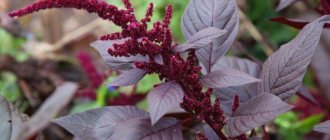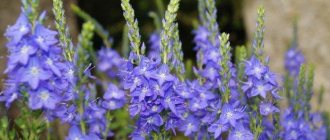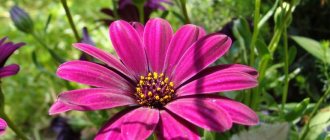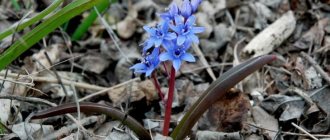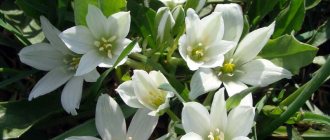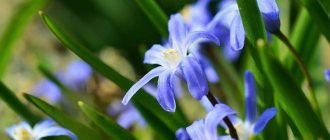This simple and familiar garden flower has incredibly powerful healing potential; many herbalists call its medicinal properties almost a panacea for all ills. Many people know calendula under the name “marigold”, and until recently it was difficult to find a summer cottage where these bright yellow-orange flowers would not be planted. Today, ceremonial flower beds are increasingly inhabited by tropical exotics and other stars of garden design, but in terms of its universal qualities, the humble calendula still remains unrivaled. It is a healer, a cosmetologist, an element of festive side dishes of haute cuisine, protection from harmful insects, and simply an elegant flower and a bright, cheerful accent in the landscape of a personal plot.
general description
Calendula is a branched flowering annual or perennial that can take a herbaceous or subshrub form. Belongs to the Astrov family. The stems are pubescent, straight, lodging in most species, with a ribbed cross-section. The arrangement of the leaves is alternate, their shape is oval-elongated or lanceolate. Long peduncles bear buds high above the curtain, forming at the ends single basket-type inflorescences, painted in a sunny range of colors - from pale yellow to deep orange with a brown-burgundy edging.
Flowering is very long, lasting almost the entire warm season. The buds open anew every day and close in the evening at sunset. Only in the most cloudy and rainy weather can they remain closed all day.
Calendula seeds have a curved shape, which led to the popular name of the flower “marigold”. Their germination persists for 4-5 years.
Care
There are no special recommendations for caring for calendula. This plant is very unpretentious and has excellent immunity against diseases. In dry times, it is necessary to ensure sufficient watering. The soil near the bushes should be loosened periodically, this will speed up growth and give more abundant and longer flowering.
Weeding is done to maintain the aesthetic appearance of a flowerbed or garden bed. Some of the weeds will hide on their own. In rare cases, calendula suffers from powdery mildew, which requires appropriate treatment with fungicides.
Collecting seeds
Longer flowering of the plant is achieved by removing fading inflorescences. For medicinal purposes, flowers must be picked in the full opening phase.
Seeds ripen at the end of summer. These are large shoots, gray-brown in color, resembling the letter “C”. Remove the marigold flowers shown in the photo, leaving a stem of 3 cm - this will not allow the inflorescences to fall apart during drying. They are laid out to dry in a dark place. When the material has dried, it must be winnowed, then placed for storage in paper or fabric bags.
Calendula is not only a beautiful, but also a useful plant. It will delight you with flowering from mid-summer until the onset of frost. Often, re-sowing is not required - seeds that fall to the ground will germinate on their own. The collected “marigolds” are used to treat diseases of the gastrointestinal tract and vascular system; They are used to make decoctions and tinctures that help strengthen the immune system, reduce the risk of tumors, and eliminate inflammatory processes.
Similar articles:
Types and varieties, beneficial properties of Actinidia arguta,…
Birch - description, species names and beneficial properties
Useful properties of cornflower and features of its content
Varieties of calendula
Within the genus, about 20 plant species have been described. Based on them, many decorative garden forms have been developed, however, most often in gardens you can find calendula officinalis. For those who plant marigolds solely to obtain medicinal raw materials, you should know that the development of new varieties is carried out in two directions at once - medicinal and decorative. Moreover, Russian breeders are more focused on medicinal raw materials. Therefore, when choosing seeds for planting for the purpose of collecting and using medicinal material, you should not limit it to one well-known species.
Calendula field
A low annual variety up to 30 cm. Thick, straight stems are softly pubescent, highly branched. Along the entire length of the shoots, petiolate sessile leaves are arranged in a regular order. The flowers are solitary, small, pale mustard color. It is not in great demand among gardeners, but is often sold in flower seed stores.
Calendula officinalis
The flowers of this variety are grown commercially for the pharmaceutical industry and are the most famous and widespread type of plant. It is correct to consider them “marigolds”. It is also an annual plant, but can have more impressive dimensions than the previous species, up to 70 cm. The shoots are straight, highly branched, colored in the same light green tone with oval simple leaves. The leaf blades are finely and softly pubescent. The flowers are yellow-orange with a slight transition to brown, the upper surface of the petals is smooth, shiny, the lower surface is matte. The central part of the inflorescence is strewn with small tubular petals, painted in the same colors. Flowering begins relatively late, by mid-summer, but continues almost until the first snow. The plant produces numerous seeds with excellent germination, which lasts up to 5 years.
Based on calendula officinalis, numerous varieties of decorative and medicinal purposes have been bred.
Both have medicinal properties and applications, but the former have priority qualities such as external characteristics and duration of flowering.
Calendula "Radio"
Medium-sized terry and semi-double, depending on the variety, grows up to half a meter. Rigid shoots with a ribbed cross-section have increased rigidity, branch well, but almost do not bend. A characteristic feature of the species is the petals twisted into a tube, the diverging rays of which are similar to antennas and look original and impressive. The inflorescences are yellow-orange, slightly lighter in the middle, and quite large, especially in double varieties.
Variety "Bonbon"
The inflorescences of this variety have an external resemblance to marigolds, of a densely double type, with a rich yellow color. The stems are compact, up to 30 cm in height.
Variety "Indian Prince"
Very colorful flowers, painted in bright exotic colors. This is a tall variety, the stems of which reach 75 cm. The flowers are large, semi-double, with petals curved inward at the ends. In the center the petals are tubular, dark, with a transition to burgundy or bronze-brown. Grown by florists for cutting and making bouquets.
Popular varieties of calendula officinalis, or marigold
A calendula bush can be from 20 to 75 cm in height, the inflorescences are single baskets with a specific aroma, they can be plain - cream, light yellow, bright yellow, orange, and also bicolor .
Among the low-growing varieties, the Gitana group is especially popular, the height of these plants is 30-35 cm, double inflorescences, up to 4 cm in diameter with different colors Orange Gitana - bright orange with a dark center, Fiesta Gitana - a mixture of colors.
Among tall people, the most popular groups are
Calendula officinalis Ball's: Ball's Jrange - orange-yellow, Ball's Gold - yellow inflorescences
Calendula officinalis Cablouna: Cablouna Gold-gelb - yellow inflorescences,
Calendula officinalis Pacific: Pacific Apricosenfarbe - light yellow inflorescences with orange stripes and a dark center and others.
Calendula officinalis Pacific
More interesting varieties and groups of calendula varieties
Calendula officinalis Greenheart (variety in the entry photo) - large bright orange double flowers with green contrasting centers. It stands very well when cut.
Calendula officinalis Greenheart
Calendula officinalis Bronze Beauty (Touch of Red Buff) - pale cream narrow petals with red tips.
Calendula officinalis Bronze Beauty (Touch of Red Buff)
Calendula officinalis Princess (orange black center) - orange flowers with a black center, 60 cm high.
Calendula variety Princess
Growing Calendula
Caring for the plant is completely easy due to its unpretentious nature and natural adaptability to the climatic conditions of central Russia and its colder regions. For successful flowering you need to choose an open place. Calendula will easily tolerate temporary openwork shading, but will feel depressed in the absence of sun for a long time. In addition, the risk of powdery mildew will increase.
Watering
During the period of increasing the initial green mass, calendula requires a sufficient amount of water. Mature bushes can easily tolerate short dry periods, although if they occur during budding, the number of flowers can be significantly reduced.
To ensure flowering lasts longer, the flowers should be partially removed by periodically cutting them off.
This will allow the collection of medicinal raw materials for the benefit of the decorative appearance of the planting, the abundance and duration of its flowering.
Collection of raw materials
The best time to collect homemade calendula is when the plant reaches the peak of its flowering, i.e. most of the flowers will already be open. It is best to prepare them for further use in the morning in clear weather, after waiting for the dew to dry. The inflorescences are torn off, capturing a small part of the peduncle, and then dried in the shade in a well-ventilated place, for example, under a canopy outside in the absence of wind.
Collecting seeds
Even if the procurement and further use of seed material is not included in the plans of the site owners, it is better to collect the seeds to avoid self-seeding and uncontrolled growth of the planting. You need to start doing this as soon as they begin to crumble and the basket begins to darken. If the seeds are needed for further use, they will ripen perfectly in the cut basket while it is drying.
The plant is useful not only to humans, but also to the soil on which it grows and to other neighboring crops. Calendula grass and its underground part have the ability to disinfect the soil from pathogens and repel insect pests.
Planting calendula in open ground
What time to plant
After the plants have 5 or 6 leaves, they should be transplanted into open soil. As a rule, this time falls in the second half of May. But it should be remembered that before planting, the seedlings will need to be hardened off, and this despite the fact that these flowers are quite winter-hardy and tolerate spring frosts well at night. To harden the plants, you need to transfer them every day for a short period of time to a covered terrace or balcony for seven days.
For planting, you need to choose a lighted area, and the soil should be moist, well-drained and saturated with nutrients. Experienced gardeners try to plant such flowers in the inter-rows of other garden and vegetable crops, which is a preventive measure against certain harmful insects (ticks, butterflies and their larvae). However, you cannot plant such a plant next to basil or radishes, as otherwise they will grow very slowly.
How to plant
Seedlings should be planted in open soil using the same scheme as when sowing such a flower in the garden. So, between the bushes you need to maintain a distance of 25 to 30 centimeters, and between the rows you need to leave a distance of 0.6 to 0.7 m. At the same time, for plants grown to create medicinal raw materials, you will need a distance of 7–10 centimeters, while the row spacing should be from 0.3 to 0.4 meters. Plants begin to bloom 40 to 50 days after sowing the seeds.
This plant can reproduce independently by self-sowing.
Diseases and pests
While repelling the vast majority of insects, calendula can only be affected by black and green aphids, the main carriers of which are ants. Therefore, it is necessary to fight not only and not so much with the pests themselves, but with their carriers; for this purpose, specialized stores have special preparations, including those for preventive purposes.
Of the diseases, the main troubles of calendula are gray rot and powdery mildew, which can easily be caused by too thick planting. If you notice dark or powdery spots on the leaves and shoots, you must immediately destroy the infected plants by burning them outside the garden area. Another provoking factor may be excessive or illiterate application of fertilizers.
Caring for calendula in the garden
Caring for your nails is very easy. So, they need to be watered only during periods of prolonged drought; they should also loosen the surface of the area and remove weeds from it. Calendula also requires fertilizing with complex mineral fertilizers once a month. But when growing such a flower, you should remember that after the position of the opened inflorescences becomes horizontal, you should remove from the bush all those flowers that are already open, this will allow the plant to bloom even longer and more luxuriantly. As a result of this, a lot of buds will appear, and the calendula will bloom for a long time. But at the same time, fully opened inflorescences must be picked off regularly. If you do not do this, the plants will bloom in the last days of July.
How to propagate
This plant is propagated exclusively by seeds.
Pests and diseases
It happens that these flowers become infected with powdery mildew or black spot. If brown or black spots appear on the leaf blades, this means that it is infected with black spot. In case of infection with powdery mildew, a whitish coating appears on the shoots, leaf blades and flowers, which becomes brown over time, the infected parts stop growing and change their color to black. The infected plant becomes less frost-resistant. You can get rid of such diseases by treating infected bushes with fungicidal agents (Topaz, Topsin, Skor or Fundazol). Preventive measures:
- thin out plantings in a timely manner;
- remove weeds in a timely manner;
- feed flowers correctly, especially paying attention to nitrogen-containing fertilizers;
- remove plant residues from the site;
- carry out deep digging of the site in the autumn;
- remember the rules of crop rotation;
- identify diseased bushes in a timely manner and remove them from the site.
Only aphids can settle on this flower, while other pests avoid it. This plant has one peculiarity - it is able to attract all the aphids present in the garden, which greatly facilitates the fight against such a pest. To destroy it, you should use such means as: Karbafos, Fufanon, Actellik, Antitlin, Akarin or Biotlin.
Selecting seeds for planting
Before sowing seeds, they should be inspected. You should know that the most profusely flowering specimens can be obtained from thin, highly curved seeds. Wide and slightly curved seeds produce less fertile and strong plants.
Helpful neighborhood
Calendula can be grown not only in flower beds and in the garden, but also between beds with vegetables and other garden crops. Its smell serves as good protection against butterflies and other garden pests, including the Colorado potato beetle and spider mite. Plants near calendula are rarely affected by thrips and blackleg. However, it is not recommended to plant calendula too close to other crops, as this may slow down their growth and development due to the allopathic properties of this flower. Close proximity to basil and cruciferous vegetables (cabbage, radish, etc.) is especially undesirable.
Perennial types of calendula cannot be transplanted to a new location, since the plant forms a strong and extensive, but easily damaged root system.
Planting and propagation
The vast majority of calendula varieties for the garden are annuals, so they are grown from seeds. They are sown immediately in open ground, because it is faster and easier than with seedlings. Seedlings are relevant only for certain low-growing ornamental varieties in order to achieve early flowering.
Calendula is sown in the garden before winter in October or as early as April. A couple of weeks before planting, dig up the area with fertilizers and humus. The seeds are distributed in rows with a distance of about 60 cm between them. The depth of embedding is no more than 2 cm.
As the shoots appear, do not forget to thin them out so that there is at least 25 cm between the bushes. But if calendula is grown only for medicinal purposes, 15 cm is enough. About 2.5 months after germination, the calendula will bloom.
Photo: zen.yandex.ru
Chemical composition of calendula
The composition of the beneficial elements of the plant is very extensive; we will present only the main ones, the most important for medicinal use.
- Carotenoids. Help relieve inflammatory processes and have an antitumor effect, including malignant neoplasms.
- Sterols. Helps in the functioning of the heart and blood vessels, removing bad cholesterol.
- Triterpenoids. Stabilization of blood glucose levels, stimulation of the immune system.
- Flavonoids. Complex effects, including restoration of mucous membranes, removal of toxic substances, bile and radionuclides, relief of spasms.
- Calenden. Rapid scarring of skin lesions, prevention and treatment of dermatitis and eczema.
- Coumarins. Reducing the risk of thrombosis, increasing vascular elasticity.
- Lactone. Antitumor effect.
This is not a complete list of the beneficial properties of calendula and the beneficial elements it contains, vitamins, acids, etc.
Useful properties for humans
Marigold flowers contain many beneficial substances . Their list includes:
- essential oils – destroy pathogens;
- flavonoids – help accelerate the production of bile, have a positive effect in the treatment of stomach ulcers, remove toxins, reduce the risk of tumors;
- coumarins – reduce the risk of inflammation;
- carotenoids – pigments that help in the synthesis of vitamin A;
- triterpenoids – help lower cholesterol, improve neural connections, relieve inflammation;
- tannins – act as protection for the surface layer of the gastrointestinal tract;
- Sterols are alcohols that have a structure similar to cholesterol, which helps lower cholesterol levels.
Additionally, the composition of calendula is rich in microelements , which also have benefits for the body:
- zinc – improves immunity;
- selenium – fights the formation of tumors, improves the functioning of the vascular system, increases the overall defense of the body;
- molybdenum – retains fluoride in the body, which reduces the rate of caries development;
- copper – fights inflammatory processes.
It will be useful! Calendula is added to various cosmetic preparations, soap, shampoo. On its basis, alcohol tinctures and decoctions are created. The latter are used for oral administration or douching. The marigolds are ground into powder for consumption raw.
Marigold flowers should not be taken during pregnancy, people with low blood pressure or heart failure. also pay attention to individual intolerance to the product.
Contraindications and side effects of using calendula
The main contraindication to taking any calendula-based products is pregnancy. The juice of the plant contains components that can promote miscarriage and provoke increased toxicosis, including uncontrollable vomiting. Calendula-based preparations and teas are not recommended for hypotensive patients due to their blood pressure-lowering effect. Age under 12 years is also a contraindication to the use of calendula preparations.
Prescription marigold-based medications are not recommended to be taken together with sedative medications.
A little history
No one can say when a person’s first acquaintance with calendula occurred. It is only known that during the Roman Empire it was already grown everywhere. In the Middle Ages, this flower became widespread in France. Queen Margaret of Navarre (1492-1549) loved him very much. On the statue, which is located in the Luxembourg Gardens in Paris, the reigning lady is depicted holding a calendula flower in her hands.
Around the same time, the plant appeared in England. William Shakespeare mentioned this flower in his play “The Winter's Tale”: “The calendula that goes to bed with the sun and rises with it.” The distinctive feature that the poet spoke about is the ability of calendula to announce the onset of day and night. Bright yellow flowers open with the first rays of the sun, turn after the sun and close when it sets or hides behind the clouds.
For this property, in ancient times the plant was called the bride of summer, the flower of the sun or the sun dial. This is where the Latin name for calendula comes from, because calendae means the first day of the month.
The earliest mentions of calendula in Russian publications date back to the 18th century. Thus, the famous naturalist A.T. Bolotov described in his works methods for treating eye diseases with the help of this plant. Later, pharmacologist A.P. Nelyubin wrote that calendula has “special healing powers.”
Thanks to its outstanding medicinal properties, calendula quickly won its place in Russian gardens. But the Latin name has not caught on with us, and among the people the flower is better known as marigolds ( marigolds , capes ) or crocis . The encyclopedic dictionary of Brockhaus and Efron, published in 1897, already contains information about marigolds. There they are called the most common species growing in Russia.
What are the benefits of the plant
- Actively used to cure neuroses and stress. She also shows herself well in the fight against the unpleasant manifestations of menopause.
- Flowers have choleretic, diuretic, anti-inflammatory and antiseptic effects. They also help with stomatitis, pharyngitis and periodontal disease. There is an opinion that with the help of calendula you can cure oncology.
- Ulcers and some types of gastritis are treated using infusions made from calendula flowers. The tincture is actively used to treat carbuncles, ulcers and acne.
- Calendula is also used to get rid of calluses, acne, and when caring for oily skin.
- The plant has properties that allow it to be used during viral epidemics.
- As an essential oil, calendula has been successfully used to treat thrush.
- The properties of calendula make it possible to use it in homeopathy. Allergies to the plant do not occur. Side effects are also extremely rare.
- Calendula perfectly heals wounds and ulcers.
Comments (6)
Sophia
07/21/2017 at 08:17 |
Calendula looks very beautiful and positive in a flower bed, is good for borders and is easy to care for. I collect and dry flowers, use decoctions and infusions as an anti-inflammatory agent for the skin and strengthen hair, and gargle for sore throats.Answer
Yulia Expert Plodogorod
04/07/2019 at 20:47 |
Hello, Sophia! Calendula is a truly unpretentious plant that can be used to decorate the edge of a garden path or to highlight the edge of a flower bed.
To get abundant flowering and stock up on medicinal buds, we recommend following some rules when growing a flower.
Considering that the seeds are quite large and sowing them is not difficult, it is better to immediately place them at a sufficient distance so that the bushes do not interfere with each other. The optimal distance is 20-30 centimeters.
If necessary, the interval can be reduced to 10-15 centimeters. This option is more suitable if you want to obtain raw materials for further use.
To get a large number of buds, you need to prepare the soil in advance. It is important to add fertilizers containing elements such as potassium, phosphorus, magnesium, and manganese. During the period of active growth of vegetative mass, nitrogen-containing products are required.
The soil in the place where the calendula will be planted can be dug up with rotted manure, sawdust, ash and peat. This measure will ensure sufficient nutrition and breathability of the soil.
Before planting, we recommend watering the area with a manganese solution. This will not only enrich the soil with this element, but also protect young plants from fungal diseases.
Immediately after the first true leaves appear on the plant, you can fertilize it with minerals. Before flowering, the procedure must be repeated.
For long flowering, you need to constantly remove the blooming buds. Although the preparation of the medicine in this way will occur more slowly, the plant will not lose its decorative appearance and will not be depleted.
We would like to note that calendula does not tolerate drought well. It is worth watering as the soil dries out, and especially if the bush looks lethargic. If the soil is prepared correctly before planting, this will reduce the risk of moisture stagnation in the soil.
Answer
Lera
09/05/2018 at 21:49 |
Absolutely not a whimsical flower. I grow it mainly for medicinal purposes, but this plant also looks good as a decoration. The only problem is aphids. I try to process before the period of active flowering, so that it is safe to use the flowers.
Answer
Yulia Expert Plodogorod
04/07/2019 at 21:29 |
Hello Lera! We would like to note that given that flowers are planted for further consumption, it is worth fighting aphids using gentle methods. These can be folk remedies or biological products.
First, make sure there are no anthills near the calendula. After all, it is these insects that spread aphids to plants. You can sprinkle the anthill with dry boric acid. This will not destroy it, but will encourage its inhabitants to move to another place.
To begin with, if there are not many pests, you can simply try to wash them off with water. To do this, you can use sprinkling watering or purposefully water the bush from a diffuser.
You can also prepare a soap solution, preferably using tar soap. Approximately one stick per bucket of water is used. Then this solution is poured into a spray bottle and the plant is treated. You can add baking soda to the described soap solution.
Ash is highly effective in combating both pests and diseases. You need to sprinkle this product under the plant in a layer of about one centimeter. And also spray the bush with a solution of ash, which is left to infuse for about a day. Concentration: two glasses per bucket of water.
You can use essential oils. Lavender, tea tree, cedar and thyme are suitable. You need to add about 15 drops to half a liter of water and treat the flower.
Among the drugs you can use Fitoverm. When using it, harmful insects begin to disappear after 2-3 days. In the case of aphids, a day is usually enough. Complete recovery occurs within a week. It is better to carry out processing in dry weather.
Entobacterin works well against harmful insects during the summer heat. If the weather is cold, then you need to increase the dosage.
Akarin will help to significantly reduce the aphid population, but you need to consider the type of pest that has affected your garden. There will be an effect only if it complies with the recommendations. Improvements are noticeable around the sixth day.
Answer
Nika
04/07/2019 at 15:13 |
If you plant flowers for benefit and not for beauty, then what varieties of calendula are best to choose? There is a very large selection, so it’s easy for me to get confused in these interesting varieties, but the benefits are more important.
Answer
Yulia Expert Plodogorod
04/07/2019 at 22:15 |
Hello Nika! All varieties of calendula have a medicinal effect, so in principle, you can choose a plant that you like in appearance. But those buds that have a bright orange color are considered the most useful.
It should be added that the leaves and roots also have valuable properties. They disinfect the soil, destroying the fungus. After calendula, you can safely plant strawberries, asters or peas.
As for the most medicinal varieties, you can plant Calypso based on color. This variety has a compact bush, 25-30 centimeters high, large double buds with a rich orange color.
Low Pygmy bushes with dense orange inflorescences can not only provide a supply of medicine, but also decorate the border.
Fiesta buds have bright orange petals and brownish centers. Height no more than 30 centimeters.
Symphony of summer can be grown both in open ground and in flowerpots. The flowers are plump, double and bloom in large numbers.
If you always want to have this plant on hand, you can grow balcony calendula. The inflorescences are small and look like anemone buds. Color may vary, so choose the desired shade for medicinal purposes.
Among the higher types, you can choose Radio. It has a radiant bud shape, the plant height is usually no higher than half a meter. This variety is considered universal because of its decorative and medicinal properties.
Calendula Geisha has rather large, chrysanthemum-like flowers. A distinctive feature is that at the ends of the petals the color turns from orange to red.
There are varieties that have a rather pleasant aroma. One of them is a confectioner. Terry buds have a rich color.
If you like tall plants, we recommend trying to grow an Orange Flamingo. The most interesting thing about it is the subtle smell of fruit that comes from the inflorescences. The buds themselves have thick and dense petals. The plant is quite resistant to various natural disasters.
Another decorative species is Apricot. Suitable for decorating flower beds and for preparing buds. The height of an adult bush is about 60 centimeters.
Answer

